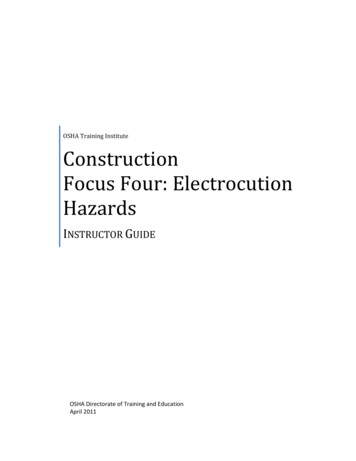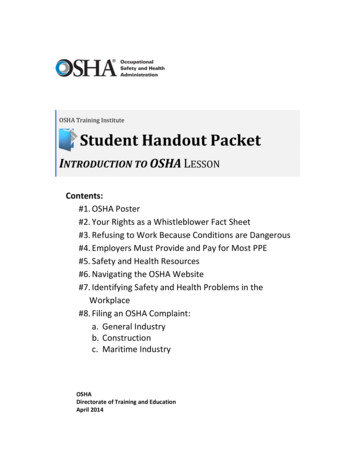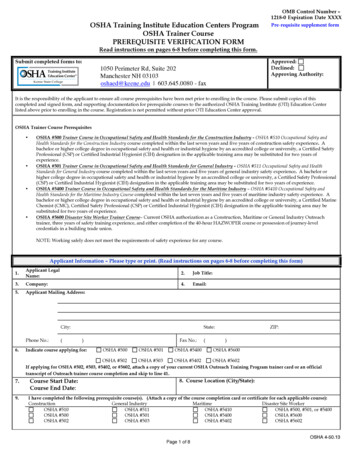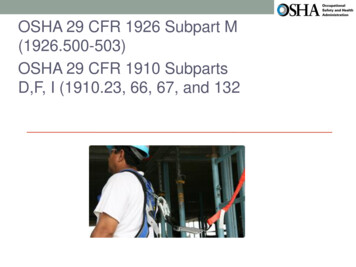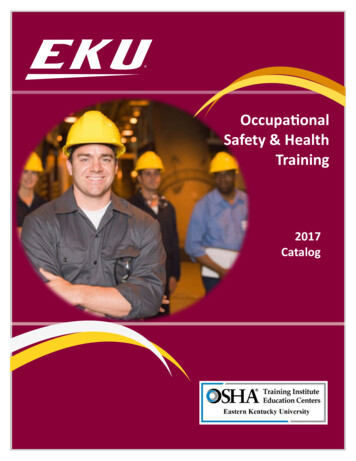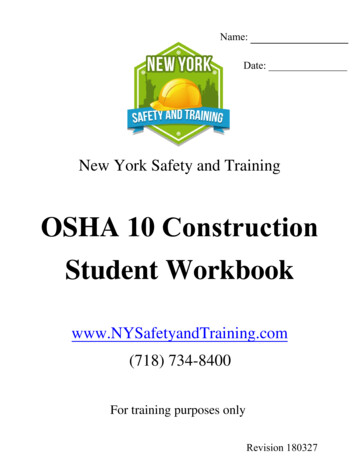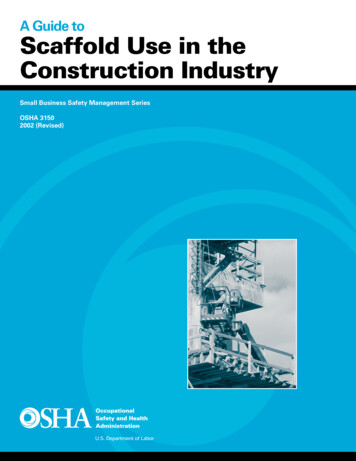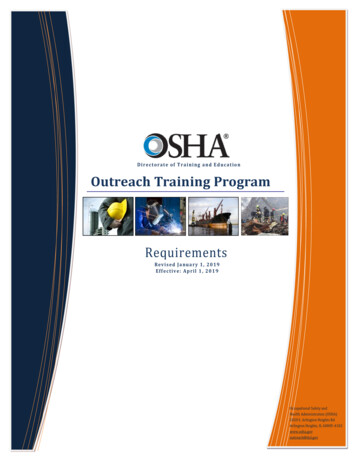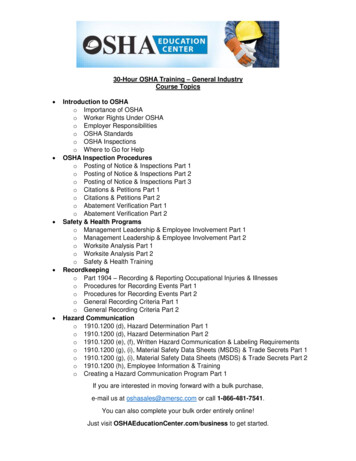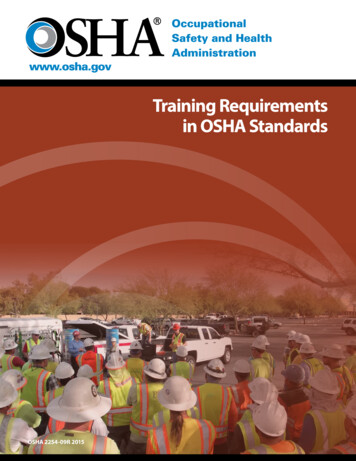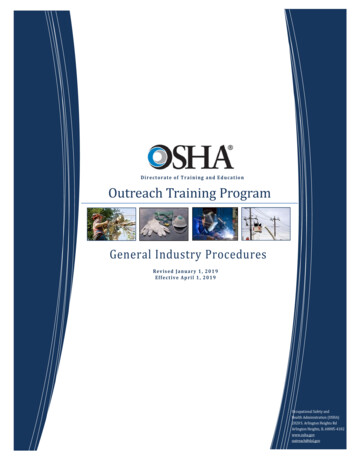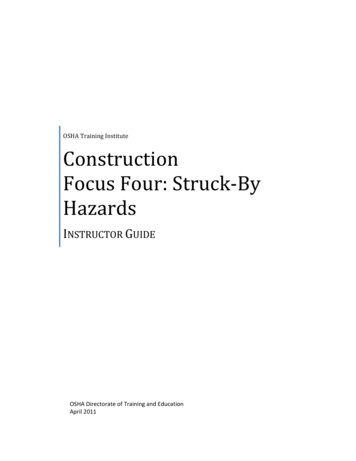
Transcription
OSHA Training InstituteConstructionFocus Four: Struck‐ByHazardsINSTRUCTOR GUIDEOSHA Directorate of Training and EducationApril 2011
Construction Focus Four: Struck-By HazardsTable of ContentsOnline Resources . iiOverview .1Topic 1: What is a struck-by hazard?.3A. Definition.3B. Examples .3C. Statistics .4Topic 2. What are the common types of struck-by hazards in construction?.6A. Struck-by flying object.6B. Struck-by falling object.8C. Struck-by swinging object.9D. Struck-by rolling object .10Topic 3. How can I protect myself from struck-by hazards? .12A. Heavy equipment [cranes, excavators, etc.].12B. Motor vehicles [trucks, cars, etc.] .14C. General safe work practices .15D. Personal protective equipment (PPE) .16Topic 4. What is my employer required to do to protect workers from struck-by hazards? .18A. Heavy equipment [cranes, excavators, etc.].18B. Motor vehicles [trucks, cars, etc.] .19C. General requirements for protecting workers .19D. Provide personal protective equipment (PPE).20E. Training.20Summary.22References/Sources .23APPENDIXAppendix A: Struck-By Hazards Lesson Test . A1Appendix B: Focus Four Toolbox Talks . B1Appendix C: Fatal Facts Accident Summary Reports . C1Appenidx D: Student Handouts. D104/2011
Construction Focus Four: Struck-By Hazards04/2011
Construction Focus Four: Struck-By HazardsTRAINER PREPARATION GUIDANCEThe “Construction Focus Four: Struck-By Hazards” lesson is part of the 4-hour block consisting ofsegments on each of the Focus Four Hazards: Falls, Caught-In or -Between, Struck-By and Electrocution.Because most construction fatalities are caused by fall hazards, falls must be covered for at least onehour, and we recommend at least one hour and 15 minutes. The other focus four hazards lessons, suchas this one, must be covered for a minimum of one-half hour each. This training is developed to be usedin both the 10- and 30-hour OSHA Outreach Training programs and if applicable, for other safety andhealth training purposes.Using the Instructor Guide (IG): The IG consists of instructions for trainer preparation, resources, alesson plan, references, and Appendices. The IG contains content, activities and notes for the instructor.It is not intended to be a script that is read verbatim to the students. Rather, instructors shouldreview the entire guide (including referenced materials and internet links) prior to conductingtraining, and use it as a resource in their planning and presentation.The learning objectives and testing: The “Construction Focus Four: Struck-By Hazards” lessonsegment was developed based on the terminal (TO) and enabling objectives (EO) below. Theseobjectives are the expected student outcomes; therefore, 1) the instructor may not vary from theseobjectives when planning the training session; and 2) the objectives must be measured by testing thestudent’s achievement. A test is provided in Appendix A; however, the trainer may develop a modified setof test questions to meet the needs of the audience as well as to measure the student’s achievement ofthe stated objectives.TO: Given current OSHA and industry information regarding construction worksite illnesses, injuriesand/or fatalities, the student will be able to recognize struck-by hazards in construction.Specifically, the student will be able to:EO 1: Identify common struck-by hazardsEO 2: Describe types of struck-by hazardsEO 3: Protect themselves from struck-by hazardsEO 4: Recognize employer requirements to protect workers from struck-by hazardsUsing the Slide Presentation: The Microsoft PowerPoint 2003 presentation file consists of struck-byhazard recognition photos which the trainer may use as an activity during the session. The presentationformat is one slide asking if students recognize any hazards followed by a slide displaying the samephoto containing the answer. The instructor may add additional slides to the presentation based on thelesson content or use their own slides, if appropriate to the lesson content.Appendices: Provided in the Appendices are the instructor and student copies of the lesson test, lessonactivity documents along with student handouts. Refer to the Table of Contents for details.Media and/or Teaching Methods: This lesson is one of four segments covering the construction focusfour hazards. It has been set up as a facilitated, interactive training session. Students are given small“chunks” of information, and then are able to practice their understanding of the subject matter viaactivities and workshops. There is a lesson test provided for each focus four segment.Ideal Setting or Conditions for the Training Session: The ideal setting is a classroom or other areawhere students have space to break into groups.Disclaimer: This Compliance Assistance product is not a standard or regulation, and it creates no newlegal obligations. The Compliance Assistance product is advisory in nature, informational in content, and isintended to assist employers in providing a safe and healthful workplace. Pursuant to the OccupationalSafety and Health Act, employers must comply with safety and health standards promulgated by OSHA orby a State with an OSHA-approved State Plan. In addition, pursuant to Section 5(a)(1), the General DutyClause of the Act, employers must provide their employees with a workplace free from recognized hazardslikely to cause death or serious physical harm. Employers can be cited for violating the General Duty Clauseif there is a recognized hazard and they do not take reasonable steps to prevent or to abate the hazard.However, failure to implement these recommendations is not, in itself, a violation of the General DutyClause. Citations can only be based on standards, regulations, and the General Duty Clause.04/2011Page i
Construction Focus Four: Struck-By HazardsOnline ResourcesBureau of Labor Statistics, Census of Fatal Occupational Injuries http://www.bls.gov/iif/oshcfoi1.htmElectronic Library of Construction Occupational Safety & Health materials, Struck-by Hazards - developedby CPWR, Center for Construction Research and Training, with funding from NIOSH NOTE: Materialsmay be copyrighted. ail Gun Safety, CPWR Hazard ty%202pg%20flier%20FINAL.pdfNIOSH Safety and Health Topic: Construction Safety /National Institute for Occupational Safety and Health (NIOSH) Publication No. 98-142 Preventing WorkerInjuries and Deaths from Traffic-Related Motor Vehicle Crashes http://www.cdc.gov/niosh/motralrt.htmlOSHA Cranes and Derricks in Construction Final Rule, Compliance Assistance Fact ml Fact Sheets include: Cranes and Derricks in Construction: Final Rule. Significant changes, requirements, andbenefits for the new rule Cranes and Derricks in Construction: Assembly and Disassembly, Subpart CC Cranes and Derricks in Construction: Operator Qualification and Certification, Subpart CC Cranes and Derricks in Construction: Signal Person Qualification, Subpart CC Cranes and Derricks in Construction: Qualified Rigger, Subpart CCOSHA Directorate of Construction: Highway Work Zones and Signs, Signals, and Barricades Topic Pagehttp://www.osha.gov/doc/highway workzones/index.htmlOSHA Construction eTools: Scaffolding: http://www.osha.gov/SLTC/etools/scaffolding/ Struck-by: kby/mainpage.htmlOSHA Grant Product (SH-17792-08-60-F-48) Big Four Construction Hazards: Struck-by Hazardshttp://www.osha.gov/dte/grant materials/fy08/sh-17792-08/struck by english r6.pdfOSHA Small Business Handbook (includes self-inspection usiness/small-business.htmlOSHA Publication 3106, (1998) Concrete and Masonry htmlOSHA Quick Cards (also available in Spanish) http://www.osha.gov/OshDoc/quickcards.htmlQuick Cards related to struck-by hazards include:· Aerial Lifts· Demolition· Chain Saw Safety Tips· Supported Scaffold Inspection Tips· Construction Hazards (Top Four)· Supported Scaffold Safety Tips· Construction PPE· Work Zone Traffic Safety· Crane SafetyOSHA Weekly Reports of Fatalities, Catastrophes, and Other Events:http://www.osha.gov/dep/fatcat/dep fatcat.html04/2011Page ii
Construction Focus Four: Struck-By HazardsOverviewThe purpose of this lesson is to provide workers with information that willenable them to recognize common struck-by hazards at construction worksites.This Instructor Guide is intended to be used when presenting the OSHATraining Institute Construction Outreach 10- and 30-hour course. The lesson iscomprised of the following four topics:1.2.3.4.What is a struck-by hazard?What are the common types of struck-by hazards in construction?How can I protect myself from struck-by hazards?What is my employer required to do to protect workers from struckby hazards?Materials Needed Flip chart and markersPresentation slidesStudent handoutsStudent copies ofplanned activitiesCopy of the OSHAConstruction StandardsCopies of Fatal FactsAccident Summary(s)worksheets for studentsCopies of test forstudentsIf activity files are usedfor hazard recognition,copyPPTinstrHazRecAlt StruckBy April2011.pdfandPPTstudentHazRecAltStruckBy outs Review Helpful CPWR Hazard Alert –References/OnlineNail Gun SafetyResources listed in this Focus 4 “Cranes anddocumentRigging” Construction Review OSHASafety Council handoutConstruction standards PPE for Worker Review instructorChecklistmaterials on Fatal FactsAccident Reportscenarios, test, andhandouts Make student copies oftest, classroom activityOption A or B, Fatal Facts#2, #4, #8, and #51worksheets, and handoutsfound in the AppendicesPage 1
Construction Focus Four: Struck-By HazardsInstruction for this session:1. Ask the class if they can give an example of ahazard on a construction site that could cause aworker to be struck-by. Discuss the examples withthe class. Be sure that examples of the mostcommon struck-by hazards (flying, falling,swinging and rolling) are covered.2. Discuss “Content” sections of all topics.3. Show photos of struck-by hazards and have theclass identify the hazards shown in each. Obtainphotos of activities that are relevant to theaudience or use some of the photos from theHazard Recognition slides.4. If time permits, plan to conduct one of thefollowing small group activities sometime during orat the end of this session: Option A: A 36-year-old construction inspectorfor the county died when an asphalt dump truckbacked over him. The inspector was wearing anorange reflective vest and hard-hat and thedump truck had a backup alarm that wasfunctioning. The truck traveled approximately770 feet in reverse. Option B: A 56-year-old truck driver wascrushed when a crane tipped over and thecrane’s boom landed on the cab of the dumptruck in which he was sitting. The crane hadbeen lowering an empty 4-yard concretebucket, while booming out.5. Conduct the lesson test and discuss answers withthe students04/2011NOTES:Display photos of struck-byhazards to gain attention andbriefly discuss purpose of lesson.As an alternative, trainers can usetheir own photos in the hazardrecognition presentation. If thepresentation is used as provided,the trainer can use the activity filesprovided to add interactivity byhaving the students involved innote taking. To conduct theactivity, locate and print the PDFfiles titled:PPTinstrHazRecAlt StruckBy April2011.pdf andPPTstudentHazRecAlt StruckByApril2011.pdfDistribute copies of the“PPTstudentHazRecAlt StruckByApril2011.pdf” to the class.Tool Box Talks 1 and 2 are usedfor Option A or B. Distribute relatedworksheets if used. [Appendix B].Source: SH-16591-07-06-F-11IUOE National Training FundFocus Four Toolbox TalksNote: These are optional as thereis a variety of interactions[Classroom Exercises] plannedthroughout this session as well.Locate instructor and studentcopies of test in Appendix A.Page 2
Construction Focus Four: Struck-By HazardsTopic 1: What is a struck-by hazard?NOTES:A. DefinitionB. ExamplesC. StatisticsContent for Topic 1:A. DefinitionStruck-by injuries are produced by forcible contact orimpact between the injured person and an object orpiece of equipment. Having said that, it is important topoint out that in construction, struck-by hazards canresemble caught–in or –between hazards.According to OSHA, “Struck” isdefined as: injuries produced byforcible contact or impact betweenthe injured person and an object orpiece of equipment.There is a distinction which is best explained bylooking at the key factor in making a determinationbetween a Caught event and a Struck event, ask: Wasit the impact of the object alone that caused the injury?When the impact alone creates the injury, the event isconsidered as Struck. On the other hand, when theinjury is created more as a result of crushing injuriesbetween objects, the event is considered as Caught.Struck-by hazards are categorized as follows: Struck-by flying objectStruck-by falling objectStruck-by swinging objectStuck-by rolling objectB. ExamplesStruck-by hazards in construction cause accidentssuch as the following: A construction worker was hoisting bricks in abucket to the top of a building. The bucket tilted,and the bricks spilled out of the bucket, strikingthe worker in the head. The worker suffered bluntforce trauma to his head, and he died at thehospital eight days later.04/2011Page 3
Construction Focus Four: Struck-By Hazards Four workers were installing signs on a highway,when a pick-up truck changed several lanes andentered the work area. The truck struck one ofthe workers, knocking him off the road and over abridge rail. He fell approximately 18 ft and died.Four workers were struck by an exterior wallwhile attempting to lift it in place. Three of theworkers received bruises and contusions. One ofthe workers received a fractured leg and washospitalized.A construction inspector was crossing anequipment vehicle route at an interstate highwaybridge construction site. He walked into the pathof the end loader traveling the route, was runover, and killed. The loader operator wasunaware that he struck the inspector.Worker was struck by the counterweight andrevolving superstructure of an excavator when hewalked between the excavator and a hillside.Workers were pulling 60 foot sections of pipe outof a hole, using a hoist to stack them on thederrick floor. One of the workers let go of a pipesection before it was secured. As he bent over,the pipe swung around and struck him on thehead, killing him.A worker was maneuvering an overhead cranewhen a metal plate weighing approximately 7,330lbs. separated from the lifting clamp and fell,striking and killing the worker.NOTES:Provide examples of accidentsrelated to the type of work youraudience does. Locate accidentsummaries on OSHA’s website.Go mlWithin the keyword field, enter akeyword to be searched against.For example, to obtain accidentinvestigations involving struck-by,enter the keyword “struck”. To viewa list of keywords, use the keywordlist at the bottom of the AccidentInvestigation Search page.You can also check OSHA’s“Weekly Fatality Reports” at:http://www.osha.gov/dep/gatcat/dep fatcat.htmlC. StatisticsOccupational fatalities caused by struck-by hazardsare a serious concern. According to the Bureau ofLabor Statistics (BLS) report titled “Manner in whichfatal work injuries occurred, 2009” preliminary data,the category of “Contact with objects and equipment is17% of the total 4,340 fatal work injuries. Of that 17%the sub-category of “Struck-by object” was 10% [morethan half].04/2011Page 4
Construction Focus Four: Struck-By HazardsIn the table below, the 2008 numbers are shown for“Crane-Related Deaths” which shows that whenworking with cranes, the struck-by death and injurycount represents 28% of the total.Causes of Construction Worker Crane-Related Deaths &Injuries, Jan. 1–Dec. 31, 2008*# Incidents(%)DeathsInjuriesCrane collapses34 (39%)2559Overhead powerline contacts12 (14%)108Struck bycrane load12 (14%)610Struck byother crane parts10 (11%)67Other causes*20 (23%)7168854100CauseTotalNOTES:For the most current statisticaldata, or for more detail, see:http://www.bls.gov/iif/Source: Michael McCann ofCPWR - The Center forConstruction Research andTraining based on BLS data, aspresented at 2010 Crane &Rigging Conference May 27, 2010* Includes 7 highway incidents, 6 falls, 3 caught in/between, 3 struck bynon-crane falling objects, and 1 struck by lightning incidentTopic 1 Review ExerciseAsk the class to respond to the following question:What are the four categories of struck-by hazardsmentioned?04/2011Answer: Struck by flying object Struck –by falling object Struck-by swinging object Struck-by rolling objectPage 5
Construction Focus Four: Struck-By HazardsTopic 2. What are the common types of struck-byhazards in construction?A.B.C.D.NOTES:Struck-by flying objectStruck-by falling objectStruck-by swinging objectStruck-by rolling objectContent for Topic 2A. Struck-by flying objectMajor Hazards:Flying object hazard exists when something has beenthrown, hurled, or is being propelled across space. Itcan include instances when a piece of materialseparates from a tool, machine or other equipment,striking a worker, resulting in injuries or fatality.Also a hazard exists if an object is ejected under
segments on each of the Focus Four Hazards: Falls, Caught-In or -Between, Struck-By and Electrocution. Because most construction fatalities are caused by fall hazards, falls must be covered for at least oneFile Size: 984KB
